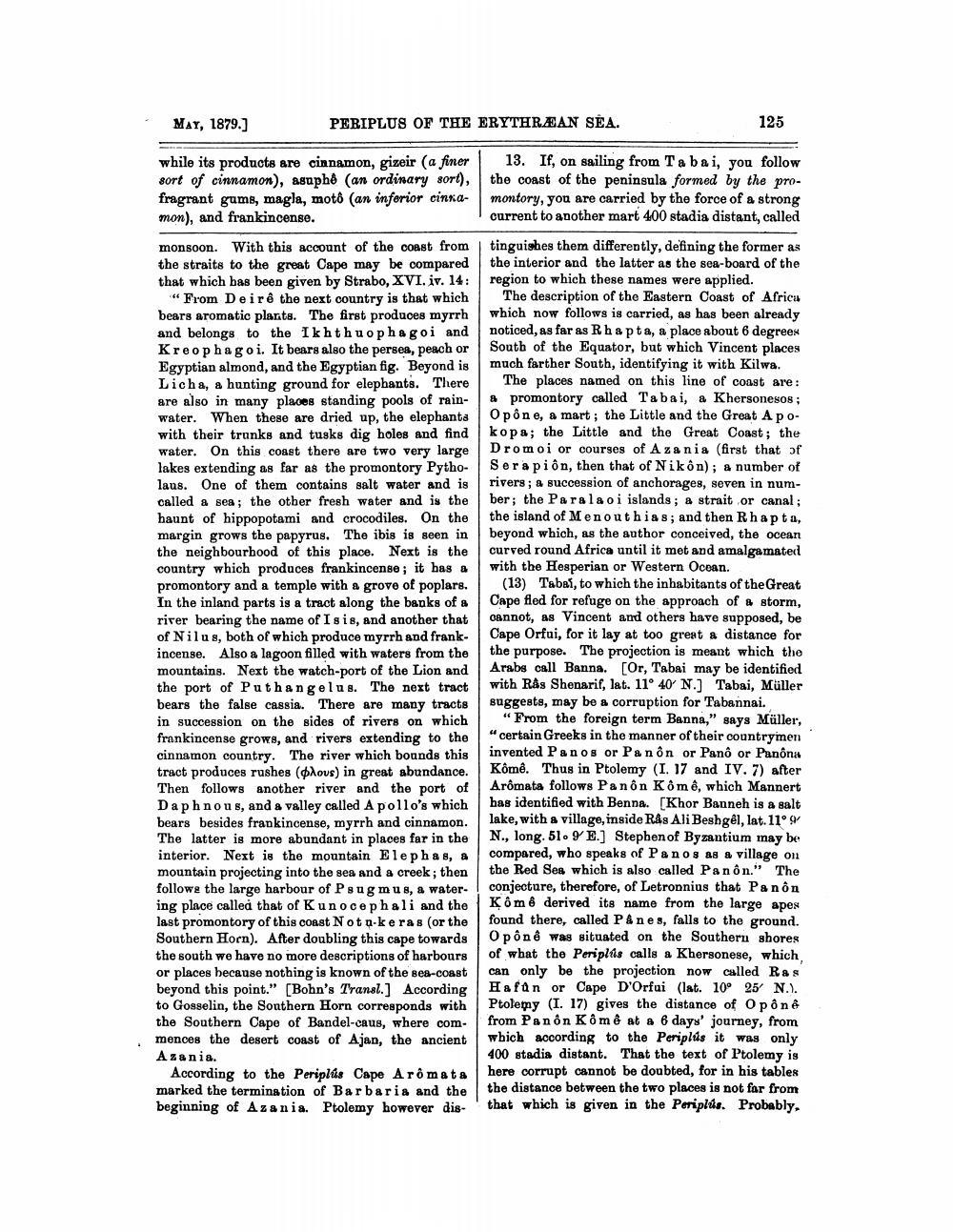________________
Mar, 1879.]
PERIPLUS OF THE ERYTHRÆAN SEA.
125
while its products are cinnamon, gizeir (a finer sort of cinnamon), asuphê (an ordinary sort), fragrant gams, magla, moto (an inferior cinka- mon), and frankincense.
13. If, on sailing from Tabai, you follow the coast of the peninsula formed by the promontory, you are carried by the force of a strong current to another mart 400 stadia distant, called
monsoon. With this account of the coast from tinguishes them differently, defining the former as the straits to the great Cape may be compared the interior and the latter as the sea-board of the that which has been given by Strabo, XVI. iv. 14: region to which these names were applied.
“From Deire the next country is that which The description of the Eastern Coast of Africa bears aromatic plants. The first produces myrrh which now follows is carried, as has been already and belongs to the Ikhthuophagoi and noticed, as far as Rhapta, a place about 6 degrees Kreophagoi. It bears also the persea, peach or South of the Equator, but which Vincent places Egyptian almond, and the Egyptian fig. Beyond is much farther South, identifying it with Kilwa. Licha, a hunting ground for elephants. There The places named on this line of coast are: are also in many places standing pools of rain- & promontory called Taba i, a Khersonesos water. When these are dried up, the elephants 1 Opône, a mart; the Little and the Great Apowith their trunks and tusks dig holes and find kopa; the Little and the Great Coast; the water. On this coast there are two very large Dromoi or courses of Azania (first that of lakes extending as far as the promontory Pytho- Serapiôn, then that of Nikon); a number of laus. One of them contains salt water and is rivers ; & succession of anchorages, seven in numcalled a sea; the other fresh water and is the ber; the Paralao i islands; a strait or canal; haunt of hippopotami and crocodiles. On the the island of Menouthias; and then Rhapta, margin grows the papyrus. The ibis is seen in beyond which, as the author conceived, the ocean the neighbourhood of this place. Next is the curved round Africa until it met and amalgamater country which produces frankincense; it has a with the Hesperian or Western Ocean. promontory and a temple with a grove of poplars. (13) Tabai, to which the inhabitants of the Great In the inland parts is a tract along the banks of Cape fled for refuge on the approach of a storm, river bearing the name of Isis, and another that cannot, as Vincent and others have supposed, be of Nilus, both of which produce myrrh and frank
Cape Orfui, for it lay at too great a distance for incense. Also a lagoon filled with waters from the the purpose. The projection is meant which the mountains. Next the watch-port of the Lion and Arabs call Banna. [Or, Tabai may be identified the port of Puthangelus. The next tract
with Ras Shenarif, lat. 11° 40' N.) Tabai, Müller bears the false cassia. There are many tracts suggests, may be a corruption for Tabannai. in succession on the sides of rivers on which
"From the foreign term Banna," says Müller, frankincense grows, and rivers extending to the
"certain Greeks in the manner of their countrymen cinnamon country. The river which bounds this invented Panos or Panôn or Panó or Panons tract produces rushes (phous) in great abundance. Kômê. Thus in Ptolemy (I. 17 and IV. 7) after Then follows another river and the port of Aromata follows Panôn Kôm ê, which Mannert Daphnous, and a valley called A pollo's which has identified with Benna. [Khor Banneh is a salt bears besides frankincense, myrrh and cinnamon.
lake, with a village, inside Ras Ali Beshgel, lat. 11° The latter is more abundant in places far in the N., long. 51. 9 E.] Stephen of Byzantium may be nterior Next in the mountain Elephas, a compared, who speaks of Panos as a village on mountain projecting into the sea and a creek; then the Red Ses which is also called Panôn." The followe the large harbour of Peugmus, & water- conjecture, therefore, of Letronnius that Panôn ing place called that of Kunocephali and the Kômé derived its name from the large apes last promontory of this coast Nota-keras (or the found there, called Pånes, falls to the ground. Southern Horn). After doubling this cape towards Oponê was situated on the Southern shores the south we have no more descriptions of harbours of what the Peripltis calls a Khersonese, which, or places because nothing is known of the sea coast can only be the projection now called Ras beyond this point." (Bohn's Transl.] According Hafan or Cape D'Orfui (lat. 10° 25 N.). to Gosselin, the Southern Horn corresponds with Ptolemy (I. 17) gives the distance of O pône the Southern Cape of Bandel-caus, where com
from Panên Kêmê at a 6 days' journey, from monces the desert coast of Ajan, the ancient
which according to the Periplus it was only Azania.
400 stadia distant. That the text of Ptolemy is According to the Periplús Cape Aromata here corrupt cannot be doubted, for in his tables marked the termination of Barbaria and the the distance between the two places is not far from beginning of Azania. Ptolemy however dis- that which is given in the Periplde. Probably.




